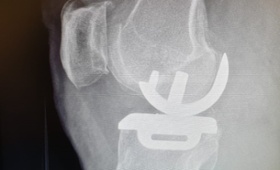The Rapid Innovation Zone
(TRIZ = Teoriya Resheniya Izobretatelskikh Zadatch)
This is my new knee – normally I don’t share pictures of my body with anyone, especially after my 5 year old granddaughter recently grabbed my upper arm and exclaimed: “Granny you don’t fit your skin anymore", but working mostly with engineers, I thought they may find this new bit of me interesting...

Artificial knees are something I have been aware of since my first year in mechanical engineering at Imperial College. Every Monday afternoon we had hours of engineering drawing supervised by the great biomechanics pioneer Professor Swanson, who always stood near me chatting to another professor. Occasionally we heard about some aspects of his work on the interface of engineering and medicine. We were all agog because we heard rumours of bags of dismembered legs being delivered to the department for his research. If true, it was all obviously worthwhile, as his famous Freeman-Swanson bi-compartmental knee prosthesis was the first of its kind in both theory and design. In 1973, Freeman and Swanson produced the next generation of their implant, by adding the anterior flange to the femoral component and a patellar button to resurface the patella. 40 years later, I am so grateful that developments from their earlier work enabled the Oxford Knee, which was then available to help me on my own journey when I required knee surgery years later.
Heads, Patents, Knees & TRIZ...
The Oxford Knee is a great illustration in the world of successful patents - which are always exciting to hear, as well as important and future changing for everyone involved. Accelerating patent work was what convinced me to shift my career to TRIZ over 20 years ago. One of my first successes was on an infringed patent of a hip joint – after patent attorneys of a major pharma company had despaired – one day of TRIZ found a way round their dilemma. Since then, Oxford TRIZ for Patents work has provided me with the most exciting, dramatic and enriching events of my career with many dramatic successes. We have worked hard to ‘bottle’ this TRIZ power to make it quickly available to teams when creating, recording and protecting important new products. However as I celebrate this Oxford Knee patent and ponder its development, I am aware that it did not involve TRIZ which maybe is why its success had such a slow burn. I have benefited from its eventual acceptance – we hope that with Oxford TRIZ other such products will change lives sooner and faster. (TRIZ offers the maps to successfully travel through the ‘wild west territory’ of IP development, reducing risk, increasing innovation and ensuring that the right paths are uncovered.)
Read how using Oxford TRIZ and Sanofi went from writing six patents to 276 patents per annum >>
The Oxford Knee and Me
My journey to my new knee has been a long one. Almost 10 years ago I damaged my knee – the pain was astonishing – preventing sleep and many normal activities, Seeking help from a brilliant knee surgeon, I was amazed that one injection miraculously set me right – it lasted for years. Grateful to be back to normal I threw myself back into the fast lane of Oxford TRIZ workshops and its development momentum. Last summer, knee pain slowed me down again and my husband complained that I was walking like a penguin, so I blithely returned to my knee surgeon to request and receive another injection. Sadly, this gave me relief for only weeks (not years as I hoped). X-rays revealed the problem on the inside of my right knee was no cartilage, with bone scraping on bone. I asked about cartilage regrowth techniques etc. but accepted that I needed a new half knee (an Oxford Knee). This rang bells in my memory and then I remembered tales of the Oxford Knee patent, its history, and how many years it took to become globally accepted delaying its delivery of life changing mobility to thousands and making the fortunes of its two inventors – one I had known and the other known of, for over 30 years.
The Oxford Knee was a team effort it was invented by a knee surgeon (I still sometimes see his lovely widow) and an amazing engineer whose phenomenal success I followed with interest, as his son is married to the sister of Emma, my brilliant colleague and friend of almost 30 years. This has always seemed to me an inspiring story for all inventors with the journey from the first idea in a restaurant, sketched on a tablecloth, to amazing recognition against the odds and well-deserved rewards for two very clever men.
The story of the Oxford Knee intrigued me for as it took decades of struggle to patent and gain acceptance and illustrates how important our Oxford TRIZ work could be - reducing the odds to ensure faster success for important products in all areas especially in the area of medicine. My first IP workshop’s success exploited the function of encouraging bone growth onto titanium – as my bone fuses rather painfully with the titanium of my new knee I am glad that even in a small way TRIZ has been part of the journey to make these new joints work so well and last so long.
See dates for Developing Products and Patents Oxford TRIZ workshops in 2020>>
Walking like a Penguin...

Whatever the future, I hope TRIZ will be recognised as an important force for successful IP to be made easier and faster for everyone. I am grateful that I live in a time and place where treatments and cures are available – even ones as painful as a new half knee. Well worth it I know to get back on track - although my husband says I still walk like a penguin – I live in hope that even that is fixable.


